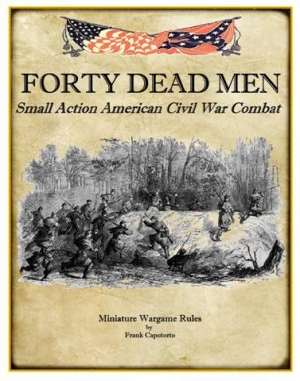|
|
|||||||||||||||||||||||||||||||||||
 |
|
The Rules Directory only works if you help. Write a review. Get the review template here. |
|
TITLE: Forty Dead Men: Small Action American Civil War Combat AUTHOR: Frank Capotorto PUBLISHER: CrookedHead Games PUBLICATION DATE: 2011 WEB SITE/SUPPORT FORUM: None listed. PRICE: 7.50 REVIEWED BY: Mark “Extra Crispy” Severin PERIOD COVERED: The American Civil War THE BOOK: Sold as a PDF download, Forty Dead Men (FDM) is 15 pages long, not including two pages of player-aid cards. The rules themselves are 13 pages long. There are two pages of markers and fire templates included. SCOPE: Tactical engagements of the American Civil War. ARMY SIZE: Infantry companies are between 4 and 10 figures, 10 companies per regiment. You will thus need 40-100 figure per regiment. For a good game you will probably need 300-400 figure per side. BASE UNIT: The base unit is an infantry company made up of 4 to 10 figures, mounted individually. GAME SCALES: There are no explicit game scales listed in the rules. Assuming a single 25mm figure is mounted on a 20mm square base, one can estimate ground scale at roughly 1” = 5 yards. BASING SIZES: FDM calls for individually mounted mounted figures, but prescribes no official basing. Multi-stand bases may be used, simply requiring a way to track individual casualties. TURN SEQUENCE: FDM uses a strict I-Go-U-Go turn sequence, with each turn comprised of the following phases:
GAME MECHANICS: Command: Each turn, officers roll for command. If they roll equal to or better than their command rating, all units within their command radius are in command and perform normally. If the officer fails his roll, each unit most roll for command. On a 1 they are severely limited in what they may do. On a 2-6 they are unaffected. Subordinate officers may extend the command radius of the overall commander (typically a colonel, but possibly a brigadier) for each side. Movement: Units have a base movement allowance, supplemented by a die roll. Terrain costs half of movement, and in some cases a unit may be disrupted by terrain. Different formations move at different speeds. Various actions such as a change of formation cost the unit’s base move (though it may still roll for additional movement). Units in disorder may not move, instead spending the turn stationary to return to good order. Fire Combat: Each unit gets a number of fire dice based on the number of figures in the unit. Dice are rolled to score hits on a 5 or 6 in most cases. Modifiers for range, terrain, formation, etc. are accounted for by modifying the number of dice thrown. For example, veteran units add 1D6 when firing. Depending on the number of hits scored the target may lose figures, suffer disorder or even rout. Units that rout retreat their base move away from the enemy. Cover serves to reduce shooting effectiveness - reducing casualties and downgrading rout to disorder. Melee: Prior to closing with the enemy, the defending unit may get off a final volley. If the attacking unit still closes after taking this fire, a melee is fought. As with fire combat, each side rolls one die for each figure involved. Modifiers for leadership, flank attacks, disorder, etc. are reflected by adding/subtracting dice. Each side rolls attempting to score hits. The side scoring more hits has won. Subtract the loser’s number of hits from the winners. The difference determines the results. Losing units take losses and retreat and may be either disordered or potentially rout. When multiple units are involved in a melee, the defender may be able to bring up support units to assist an outnumbered defender. Units engaged with more than one opponent must fight them separately, splitting their melee dice. Morale: To check morale, a D6 is rolled. If the roll is high enough the unit does not rout but is disordered instead. The target number is lower for better quality units. Combat results may call for a rout check, and routed units may be rallied during the Rally Phase. While the procedure is the same in both cases, the modifiers to the die roll vary slightly in each case. The die is modified for leadership and the presence of friendly units. Units that rout are retreated toward their table edge. Units that rally stop their rout and are disordered in place. Units that fail to rally are removed from the game. Additionally units reduced to 4 figures are automatically removed from the game. Skirmishers: The rules contain several modifications that apply to skirmishers. For example, fire against skirmishers is at reduced effectiveness (reflected in the combat results), while skirmishers under a charge may either form up or retreat. ARMY LISTS/SCENARIOS: There are no lists or scenarios included with the base rule book. A book of scenarios is available online at no charge. REVIEWER’S COMMENTS: Forty Dead Men fills a nice niche in the wargaming market for the ACW. Between skirmish level and tactical rules such as Johnny Reb or Fire & Fury, FDM will be a good set for smaller engagements involving more than a few companies. While it will take some fudging with ground scale, these should prove an easy set of rules for ACW gamers. PLAYER’S COMMENTS: Not played. |
|
[Home] [15mm World] [Reviews Home] [How To] [Beginners Guide] [Gamer's World] [Spanner & The Yank] [Points of View] [The Annex] [Links] [Say Howdy] [Corporate Schill] [Rules Directory] |
 |
